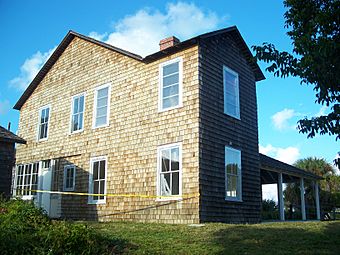Jupiter Inlet Historic and Archeological Site facts for kids
Quick facts for kids |
|
|
Jupiter Inlet Historic and Archeological Site
|
|

Dubois House, on Jupiter Inlet Midden
|
|
| Location | Jupiter, Florida |
|---|---|
| Area | 32 acres (0.13 km2) |
| NRHP reference No. | 85003486 |
| Added to NRHP | November 5, 1985 |
The Jupiter Inlet Historic and Archeological Site is a special place in Jupiter, Florida, where scientists study the past. It's an archeological site, which means it holds clues about people who lived there long ago. You can find it near DuBois Park, off A1A.
This site was once a village called Hobe (or Jobe) built by the Jaega people. They were Native Americans who lived in this part of Florida. The name "Hobe" later helped inspire the name of the modern town, Jupiter. On November 5, 1985, this important site was added to the U.S. National Register of Historic Places. This means it's recognized as a significant historical place.
Contents
What is the Jupiter Inlet Site?
The Jupiter Inlet Historic and Archeological Site is a place where history comes alive. It's mainly known for a very old shell midden. A midden is like a giant pile of shells and other things left behind by people who lived there thousands of years ago. It shows us what they ate and how they lived.
This site is important because it helps us learn about the Jaega people. They were the first known inhabitants of this area. The site covers about 32 acres (13 hectares) and holds many secrets from the past.
Who Were the Jaega People?
The Jaega people were Native Americans who lived in southeastern Florida. They were skilled hunters, fishers, and gatherers. They lived along the coast and used the ocean and rivers for food. The shell middens they created are like giant trash piles. But for archaeologists, they are treasures! These middens tell us about their diet, tools, and daily lives.
The Jaega people lived in villages, and the Jupiter Inlet site was one of their main settlements. They were part of a larger group of Native American cultures in Florida.
What is a Shell Midden?
A shell midden is a mound or pile made mostly of discarded shells. The Jaega people ate a lot of shellfish, like clams and oysters. After eating the meat, they would throw the shells into a pile. Over hundreds or even thousands of years, these piles grew very large.
Besides shells, middens can also contain animal bones, broken pottery, and tools. Archaeologists carefully dig through these layers. Each layer tells a story about a different time period. It's like reading a history book made of dirt and shells!
How Jupiter Got Its Name
The town of Jupiter, Florida, got its name in an interesting way. The Jaega village at this site was called Hobe. When Spanish explorers came to the area, they wrote the name as "Jobe."
Later, English mapmakers saw the name "Jobe" on old maps. They thought it looked similar to "Jove," which is another name for the Roman god Jupiter. So, they changed the name to Jupiter. That's how a Native American village name eventually led to the name of the modern town!
Protecting History: National Register
The Jupiter Inlet Historic and Archeological Site is listed on the National Register of Historic Places. This is an official list kept by the United States government. Being on this list means a place is very important for its history or archaeology.
This recognition helps protect the site. It ensures that future generations can also learn from the clues left behind by the Jaega people. It helps preserve this unique part of Florida's past.



